Ahmedabad is the first UNESCO World Heritage City in India. We spent one day in Ahmedabad, took the Heritage Tour at Ahmedabad Old City; ate Gujarati thali in Ahmedabad; indulged at shopping at Ahmedabad, and emerged almost Ahmedabadis at night.
We had assembled in Ahmedabad as invitees for the first-ever All India Influencer’s Meet, 2021, organised by Gujarat Tourism, Ministry of Tourism – Government Of India, and Incredible India. We had travelled to various parts of Gujarat such as Sun Temple at Modhera, Patan, all the way to attend Rann Utsav at Kutch. This was our last day in the city and the only full day in Ahmedabad before we would fly back to Delhi. So this was our only chance to warm up to Ahmedabad and we were not letting that pass by.
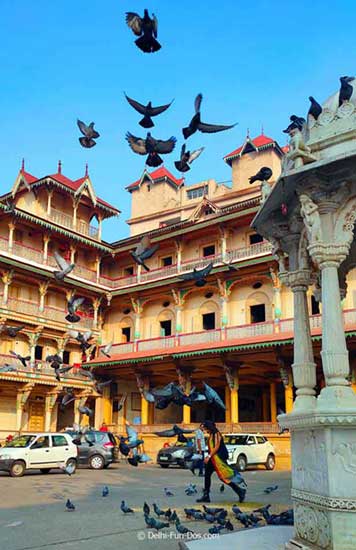
Experience Ahmedabad in a day
Contents
Ahmedabad – UNESCO World Heritage City
Ahmedabad was the first UNESCO World Heritage City in India. Erstwhile Ashwal, the name was changed to Ahmedabad after the Muslim ruler Ahmed Shah established his reign in circa 1411. Since then, for over six centuries, Ahmedabad has been the capital of Gujarat.
We reached Ahmedabad through Sardar Vallabhbhai Patel International Airport and our hotel was about 30 minutes by cab from here. On the way to the hotel, we saw a modern city, broad roads like any other city in North India. On the other hand, given that it had undergone Hindu, Muslim and British rules, it surely had more to offer!
We wanted to explore Ahmedabad as deeply as we could to find out what made it special.
What can we do in a day in Ahmedabad?
Given that we just had a day, we started bright and early. Our first activity was the Ahmedabad Heritage City Tour. Thereafter other activities were lined up.
Based on our experience, here is a guide to Ahmedabad in a single day. If you follow this, we are sure you will feel a bit Ahmedabadi at day-end.
ACTIVITY 01
Ahmedabad Heritage Walk – Ahmedabad Municipal Corporation
Our heritage walk, Ahmedabad was organised by Ahmedabad Municipal Corporation. We covered many spots during the walk and the most important ones are described below. The walk started at 7.45 in the morning and ended at about 11 in the day. We were led by the professional tour guide Yatendrasinh Ramlawat.
Gujarati breakfast in Old City with freshly fried food
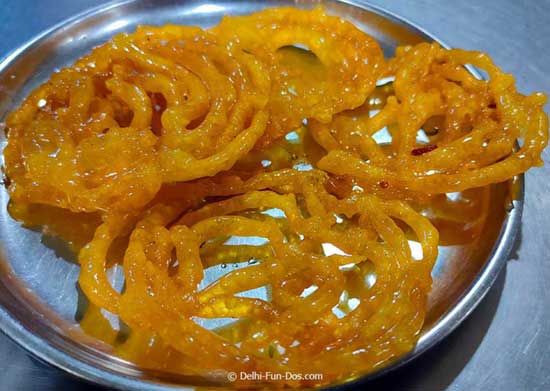
Jalebi – What Ahmedabad eats for breakfast
What do Gujaratis eat for breakfast? We got a firsthand experience when we dropped at Old City, near Bhadra Fort, and took a lane that led to the Swaminarayan Temple. Both sides of the street were lined with shops frying kachoris, fafdas and gathias. Theplas were being roasted to the customer’s satisfaction and served with chutney or curd. Fresh dhoklas and khamans were loaded on the shelves. And last but not least, as we realised during our deep exposure to Gujarati food, the dessert jalebi was also being fried in almost every shop. Needless to say, fresh jalebi is gastronomical bliss. No matter what, do stop when you find jalebis being fried and try some!
Swaminarayan Temple, Ahmedabad

Swaminarayan Temple Ahmedabad
Our first stop was the imposing gate of Swaminarayan Temple, Ahmedabad. Built about 200 years ago, this is the first of the Swaminarayan temples and was directly commissioned by Lord Swaminarayan, the original Guru of the Swaminarayan sect. Inside the gate, the sprawling area not only comprised the shrine but also living quarters for the monks and nuns and a guesthouse as well. A separate temple for women was the first time for us.
The main deity in the sanctum sanctorum is Nar-Narayan Dev, a twin avatar of Lord Vishnu. The temple is a beautiful piece of architecture with prominent Gujarati, Rajasthani, and even British influences. The statues, pillars, arches, and brackets were made of Burma teak wood to stand the test of time. The bright color ornamentation on a light yellow base made the temple look like a shrine from a fairytale.
Kavi Dalpatram Chowk, Ahmedabad
Our first look at Ahmedabad, as we mentioned above, was fairly simple. It looked like any other city in North India. The Heritage City Ahmedabad changed our opinion. The Old City comprised multi-storied villa kind of houses or Havelis. Ornate columns, door, and window frames, and carved wood brackets stood witness to the fact that this city was high on aesthete.
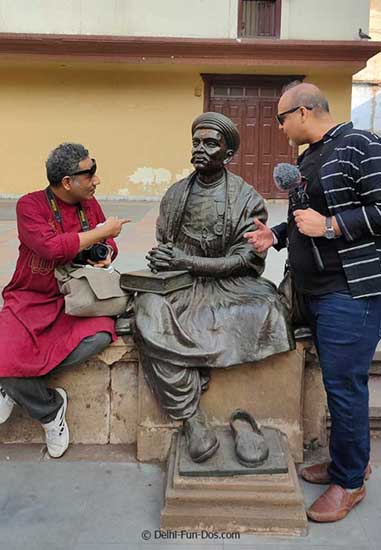
At Kavi Dalpatram Chowk in Ahmedabad
The houses were close to each other but we reached a cloister with a rather dramatic life-size statue of a man in traditional wear. He was Kavi Dalpatram, a Sanskrit scholar and Gujarati poet. While we are yet to lay our hands on translations of his works, the statue was immaculate. The courtyard was like an oasis among the tight network of houses. Don’t miss this spot if you are here.
Pols of Ahmedabad
Pols or housing clusters are a unique residential system of Old City, Ahmedabad. Members of a family or a caste or clan would live adjacent to each other in a cluster of houses. Each cluster of houses would have common courtyards and a small shrine for public worship. Each pol would have one or two entrances to maintain privacy.

Beautiful old houses and Pols of Ahmedabad
The intriguing part of the Pol houses would be the secret passages. The Pols would have many secret inroads and some secret entrances only known to the residents. The main gates of the Pol would be guarded at night. There were niches for holding lamps at the main gates. The houses inside a Pol were not spaced. Yet, their beauty was not compromised. The concrete structures would be designed with elaborately carved brackets, floral columns, and ornamental doorways and balconies. This showed us that the Pols were not a compromised lifestyle. Rather, a way of creating stronger security for the community.
The unique Pols of Ahmedabad were a major inspiration behind the city getting the UNESCO Heritage tag.
Juma Masjid, Ahmedabad
The Juma Mosque was built in the year 1424 by Ahmad Shah I. It was a grand sandstone structure and probably the largest mosque in the Indian subcontinent that was built in this period. The very spacious mosque is built at one side of an open courtyard. A reservoir for ablutions was built at the centre. The grandiose of this place in that era can still be imagined.
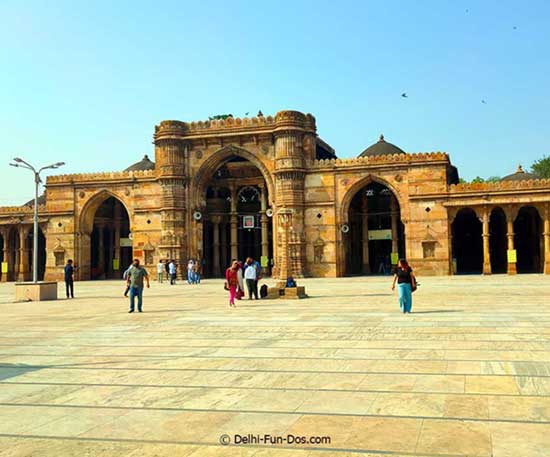
Jama Masjid is also called Juma Masjid as in Friday Mosque
The main mosque was a huge hall with innumerable, apparently 260, pillars. The pillars supported many domes and would clearly hold a large number of devotees. What struck unique to our eyes is the ornamentation of this mosque. This was a fusion of Islamic and Hindu design styles. Hence, alongside the domes and minarets typical to a mosque, lotuses and other floral designs and arches typically found at a Hindu temple were visible in this mosque.
The pattern that emerged was later called Gujarati architecture that was a mixture of Hindu and Islamic styles. It helped to create a spiritual atmosphere transcending any religious boundaries.
Tripolia Gate or Teen Darwaza, Ahmedabad
Every corner of India has its myths and legends. While exploring the Old City, Ahmedabad, we came across Teen Darwaza or three gates adjacent to each other. These gates led to the Bhadra Fort. There is an oil lamp or diya placed here that is burning for 600 years. We also learned of a mind-blowing tale associated with this diya.
Legend has it, years ago Goddess Lakshmi, the presiding deity, reached Teen Darwaza to leave the city late one night. The guard at this spot, Khawaja Siddique Kotwal recognised her. He stopped the Goddess and asked her not to leave till he returned with permission from the ruler, Ahmad Shah. Siddique left never to return and beheaded himself. This way Goddess Lakshmi was constrained to stay back in the city forever. The self-sacrifice of Khawaja Siddique Kotwal ensured the perpetual prosperity of Ahmedabad.
In deference to this incident, an eternal lamp has been burning continuously for 600 years. We saw this lamp and came to know that the lamp in ode to Goddess Lakshmi was maintained by a Muslim family.
Ahmad Shah built the Siddi Saiyyed Mosque on Bhadra Road in deference to Khawaja Siddique Kotwal. The famous Heritage Walk of Ahmedabad ended at this point and we were out of the Old City.
ACTIVITY 02
Sabarmati Ashram, Ahmedabad
Gujarat is the home of our Father of the Nation – Mahatma Gandhi. Ahmedabad had been a hub of his activities and how could we not visit a Gandhi Memorial?
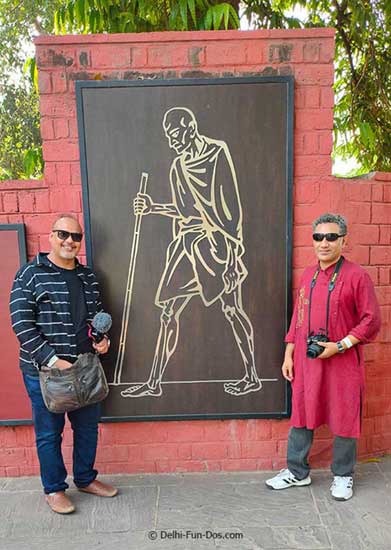
Sabarmati Ashram – A day in Ahmedabad
Our options were Dandi Kutir Museum and Sabarmati Ashram. Sabarmati Ashram was Mahatma Gandhi’s home in Ahmedabad. Dandi Kutir is a state-of-the-art museum on Gandhiji Given which was inaugurated in the year 2015. Given that we had a single day, we had to make a choice. We decided to visit Sabarmati Ashram, a pilgrimage in India’s freedom movement.
Sabarmati Ashram is located on the banks of the Sabarmati River, the lifeline of Ahmedabad. The cottage where Gandhiji lived with his wife Kasturba is beautifully maintained inside the Ashram. Objects used by the Mahatma are also on display. Given the modesty of the cottage, it is difficult to believe that dignitaries from all over the world would come and meet him here.
Sabarmati Ashram was a huge movement and the ashram had many residents. There were other cottages in the ashram that were occupied by them. There was a bookshop as well as a Khadi shop on the premises.
The Ashram was impeccably clean. But it was not just about cleanliness. Even though there were many visitors here, there was an impenetrable sense of peace. In reverence to the Apostle of Peace Mahatma Gandhi, after completing a round of the ashram, we sat for a while soaking in the moments. And hoping we come back again, time and again.
ACTIVITY 03
Lunch – Gujarati Thaali in Ahmedabad
We are big fans of Gujarati food and Gujarati thali or platter is a star on the Indian food sky. Therefore our lunch had to be a Gujarati thali and we had this at Gordhan Thal, Sarkhej, Gandhinagar. It was about 2.30 in the afternoon and the place was swarming with diners. There was some waiting. Finally, we spotted 2 seats at a table.

Gujarati Thali at Gordhan Thal in Ahmedabad
The elaborate thali started from Chhnach or buttermilk, many vegetable curries, Kadhi, farsan (snacks) such as dhokla and fritters, pickle, salad, jalebi, and Mattha (a creamy dessert). Each dish was served on the table, one after the other. It was not only gastronomical but also a photographer’s delight. Amongst the many dishes, the star had to be the Mattha. It was somewhat like thickened yoghurt-based Srikhand, but milder and with sliced fruits. We were already very hungry after the Ahmedabad Heritage Tour and the Sabarmati Ashram. Hence it did not take us very long to polish off the elaborate fare.
Also Read: All The Food We Savored On Our Gujarat Trip
ACTIVITY 04
Adalaj Stepwell or Adalaj ni Vav, Ahmedabad
We were a little iffy in terms of time but we could not drop Adalaj Stepwell, an icon of Ahmedabad. We had already visited Rani ki Vav, a stepwell in Patan, Gujarat, and a UNESCO Heritage Site. However, built in the 15th century this was another piece of history right in Ahmedabad. The well was built by Queen Rudabai in memory of her husband Rana Veer Singh of the Vaghela dynasty.
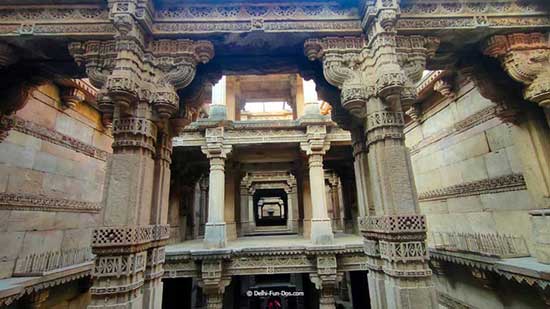
Adalaj ni Vav had 2 wells. One was a tank to collect drinking water. The adjacent well was a reservoir for irrigation of the fields of nearby Adalaj Village. The stone step well had ornate carvings on the wall that depicted the Hindu pantheon, floral designs, animals, Rana Veer Singh’s warhorse, scenes of erotica as well as Patola weave patterns. A little shrine to the presiding deity Vagheshwari Durga (Goddess Durga mounted on a tiger) was accessible for prayers only to the locals.
The intricate designs at the stepwell were also a combination of Hindu styles with hints of Muslim architecture. Legend has it that Muslim ruler Mohammed Begda killed Rana Veer Singh in a battle and proposed marriage to the widowed Queen Rudabai. Rudabai agree to the alliance on the condition that Mohammed Begda would complete the stepwell. Mohammed Bedga agreed and commissioned his artisans to finish the work. Mohammed Begda’s artisans brought in Islamic influences in the design.
PIN IT FOR A LATER READ

When the stepwell was almost complete, Begda reminded Rudabai about her promise of marriage. To see the progress of the well, Rudabai came herself. Thereafter, she jumped into one of the tanks of the seven-story well and killed herself. Thus the story ended tragically. An angered Begda subsequently had all the architects killed and their tombs were built on the roof of the well. This story gave us goosebumps and we were glad to have visited the stepwell.
ACTIVITY 05
Gujarat Science City, Ahmedabad
A science education-cum-entertainment facility was established in the year 2002 in the vicinity of Ahmedabad. It had an IMAX 3D theatre and many galleries including space, energy, life sciences, plants, nature, and so on. It was already late afternoon and we were short of time. Hence, we checked out the marine gallery and the robotics centre.
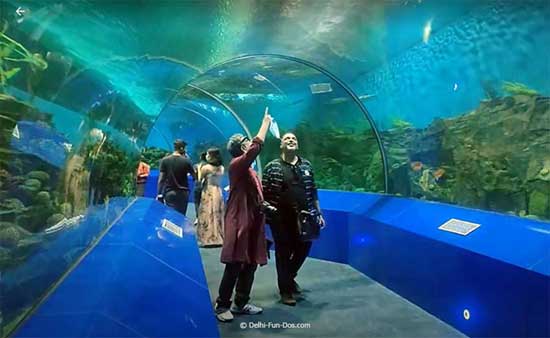
The Shark Tank at Science City Ahmedabad
The marine gallery is a state-of-the-art aquarium that would appeal to both young and young at heart. A wide variety of fish and other water creatures were displayed in aquariums on the multiple floors here. And yes, this included sharks. The most thrilling bit had to be the glass tunnel that we walked through with fish all around us. That bit seemed like heaven. There was a café here that served nice coffee and sandwiches. So, just to rest our limbs, we stopped for a cup of coffee and shared a sandwich. The other display here that you can’t miss is the African penguins. Penguins are a rarity in India and seeing these birds frolicking away was cathartic.
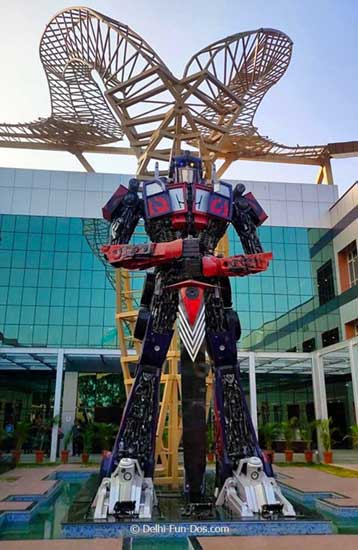
The robotics gallery was fun as well. The robots here sang, danced, and wrestled! There was a simulated driving experience too that was mighty cool. And what was even cooler was the café in the robotics gallery. Robot waiters were serving the customers their orders. We ordered another round of coffee just for the kicks. A robot came to us and was spot on in identifying us correctly while serving our beverages.
Wish we could have spent some more time here.
ACTIVITY 6
Law Garden Night Market for Gujarati Handicrafts
It was evening already and we were yet to start something very important – checking out Gujarati craft. Gujarati weaves and embroideries are treasured all across the globe. Gujarat is one of the most handlooms and handicraft-rich states of India and this history went back centuries. Be it the royal Patan Patola weave to the colourful embroideries and mirror work by the Meghwal, Ahir, and Rabari tribes, every piece was a collectible.
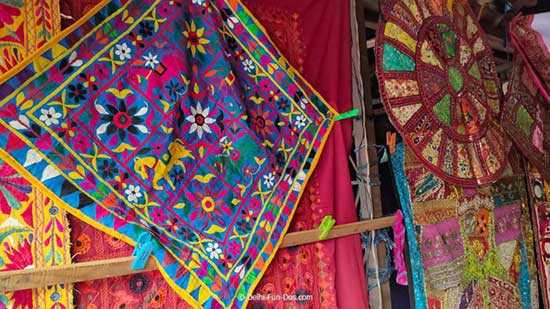
Law Garden Market – Shopping in Ahmedabad
On asking around about local handicrafts in Ahmedabad, all fingers pointed towards the Law Garden Market. It was a flea market open till the late hours of the night. The timing suited us perfectly.
Law Garden was named perhaps because of the Law College in the vicinity. Hundreds of stalls on both sides of the road sold clothes, bedcovers, bags, costume ornaments, and so on. Most of these were strictly not traditional handicrafts, but present-day inspired versions. After some hunting, we found a few shops selling old-style handicrafts as well. We bought a few pieces of Ahir tribe embroidered patches, a long panel, and a toran that were embroidered with beads by the Rabari tribe (total wow!). The market was prominently located and fuss-free in terms of the shopping experience.
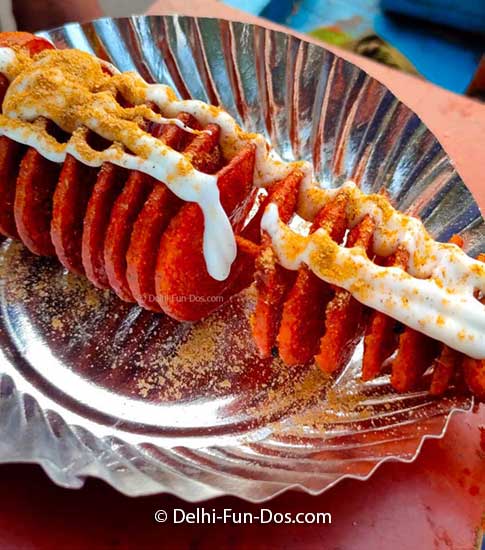
ACTIVITY 07
Dinner – Manek Chowk Food Market
Yes, street food is very popular in Ahmedabad and the locals often make dinner out of that. To this end, we had to head to Manek Chowk, perhaps the most interesting place in Ahmedabad Old City. We had crossed this area during our Ahmedabad Heritage Walk in the day. It was then a busy market selling jewelry (Manek means gemstone) and clothes.

Post 9 at night, the area is completely transformed. When the businesses close, Manek Chowk becomes the street food market of Ahmedabad. Long tables and chairs are set up on the streets and the area becomes a hub for food pop-ups. It’s a happy spot with people from everywhere, youngsters; families, children, and senior citizens come, try multiple dishes, and make way for the next diner waiting patiently. Among the countless dishes, we had Jain Gughar Sandwich and Jamun smoothie shots.
The Freshly made sandwiches were loaded with shredded cheese. Each sandwich was grilled on the flame in old-style aluminum sandwich makers and reminded us of our tiffin in school. The Jamun shots were blackberry pulp and juice served in glasses rimmed with salt. The shot was refreshing and somewhat woke us up as we were very exhausted after the long day.
From Manek Chowk, we barely had enough energy left to call a radio taxi and head to Hyatt Regency, Ahmedabad who took great care of us during our stay.
Thus concluded our single day in Ahmedabad.
Is Ahmedabad worth visiting?
Ahmedabad seemed to be a safe city for travellers. We did not waste a minute. On day-end, it was a very satiating feeling that we had a solid impression of Ahmedabad. With Juma Masjid and Sabarmati and Science City in the motorable periphery, Ahmedabad was a heady concoction of the history and arts of ancient India with the sciences of modern India. So we will say, Ahmedabad is worth it and you should keep some time for this city while travelling.
Our single day in Ahmedabad was like the entre to a good meal. We intend to come back and see more of Ahmedabad on our next trip.
PIN IT FOR A LATER READ
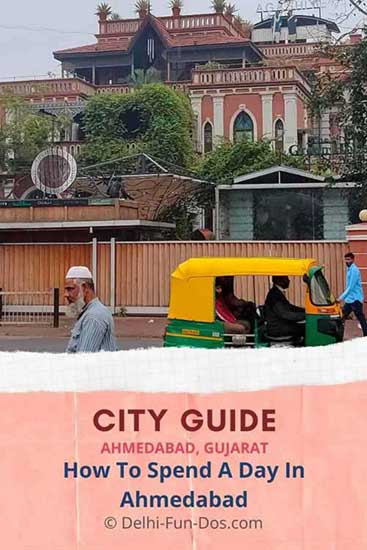
Ahmedabad’s Ganga-Jamuni Tehzeeb
Are you aware of the Ganga-Jamuni Tehzeeb? This is a syncretic fusion of Hindu cultural elements with Muslim religious elements. Given the stories behind the lamp at Teen Darwaza or the Adalaj ni Vav or the design elements of the Juma Masjid, we thought Ahmedabad’s lifestyle epitomized a syncretic culture as it could ever be.
And now we know that Ahmedabad’s tag of UNESCO World Heritage City is perfectly legit.
Pro-Tips
– The weather was most pleasant in early December. The days were sunny and warm. You could do with light winter-wear in the evenings.
– You can book the Ahmedabad Heritage Walk that we experienced from the website of Ahmedabad Municipal Corporation.
– If you are going for the Ahmedabad Heritage Walk, do be mindful of your clothes. Irrespective of gender, a visitor is expected to cover-up from top till at least below the knees. It would therefore be prudent to avoid clothing such as straps and shorts.
– Shoes need to be removed at some spots during the Heritage Walk, and at Sabarmati Ashram. Hence, slip-on footwear could be convenient.
– We used auto-rickshaws and radio-taxis by way of local transport in Ahmedabad. Everyone who drove us around was friendly.
– Gujarati is the primary language here. However, locals were very conversant in Hindi and followed workable English.
P.S. This post is in collaboration with Gujarat Tourism, the Ministry of Tourism – Government of India, and Incredible India. Our wholehearted thanks for the riveting experiences.
Also, we are grateful to Yatinji for an informative yet interesting experience.
PIN FOR LATER READ
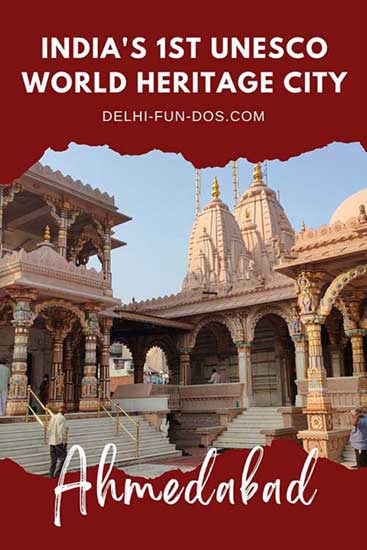


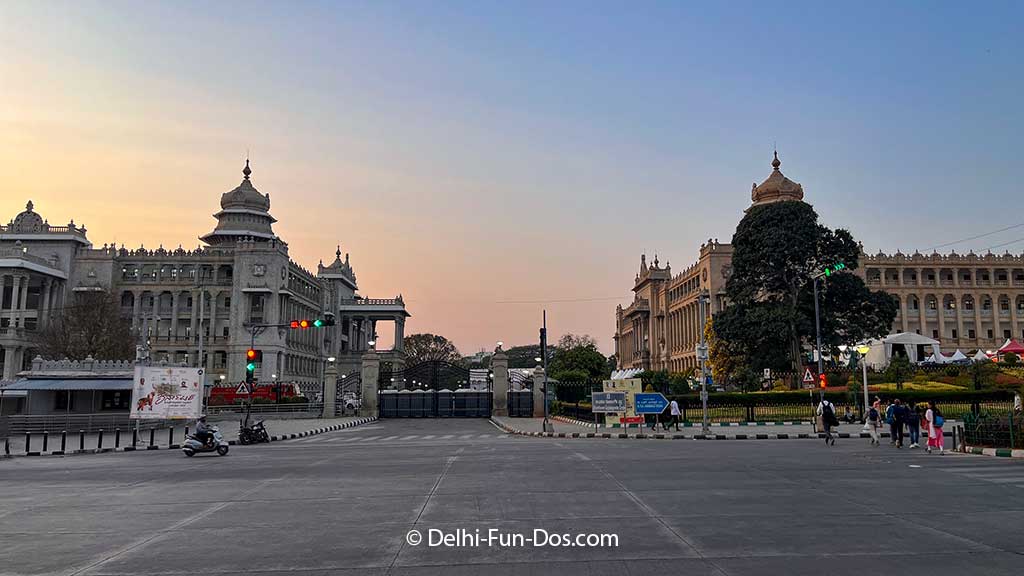
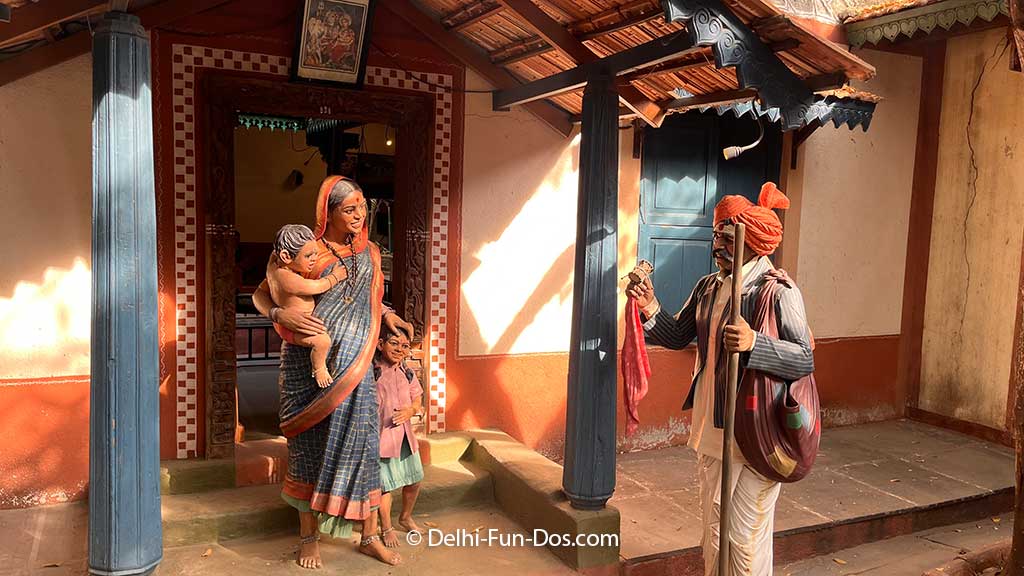
We always love experiencing Ahmedabad and also reading about it. Ahmedabad comes vibrantly alive in your pictures and words. Beginning with the Heritage walk and ending with FOOD at Manek Chowk, a day in Ahmedabad like this is sure to linger in memory for a long time.
When you say something like that, it means a lot 🙂
Ohh my God food looks so tempting and Gujarat science City is must visit place. I will love to explore this city.
You must, Ahmedabad was a pleasant surprise.
Ahmedabad is the largest city in Gujarat, so there is a lot to do and explore. If you are wondering where to start planning this article is for them. Great post.
Glad you think so 🙂
Every part of India has a rich story to share. Ahmedabad is also a gold mine when it comes to such interesting historical stories. I am amazed by the science museum, it’s so well done and the rich heritage is worth paying a visit.
Ahmedabad was a pleasant surprise.